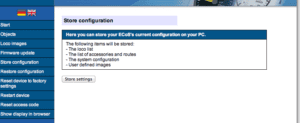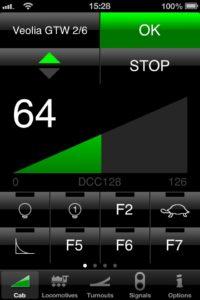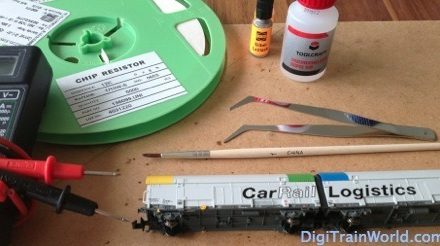What can you do with an ESU ECoS II DCC command station, apart from controlling trains? Let’s have a look at this station from another point of view: connectivity.
I haven’t had time to post lately, so I decided to write on a “classic” topic. The ESU ECoS II command station has been around for more than 3 years now. On my layout, it has replaced the Viessmann Commander, which I personally found buggy and very limited.
Its age doesn’t mean that the the ESU ECoS II isn’t able to evolve, or can’t be “connected”. This is why I am going to review all of its “connectivity options”, notwithstanding the actual “train control” possbilities.
Connections
The command station from ESU has quite a lot of “plugs”. Most of them are directly related to train control, and thus fall out of the scope of this article:
- Track, programming track
- DCC booster
- S88 feedback system
- ESU proprietary bus system (ECoS Link)…
As opposed to the Märklin Command station, it does not have a USB port or a “card slot”. The most important and versatile plug on the ECoS II is simply a classic Ethernet (RJ-45) network port.
The ECoS can thus be connected to your home network, along with your computers. Although there is no integrated WiFi, a €20 adapter can be connected to the Ethernet port itself. This is what I did, with a TP-Link TL-WR702N in “client” mode.
Now, armed with our Ethernet connection, let’s see what we can do.
1) The web interface
The ESU ECoS II, once on the home network, can be access through a standard web browser (you need to know its IP address):
The main options are:
- Update
- Picture upload
- Backup
- View screen
Firmware updates
We’ve entered the “everlasting beta” era. No device is considered reliable if it can’t be updated regularly. I have had the ECoS for more than 2 years, and it seems ESU is indeed still actively developing their firmware (about every 3 months).
Those updates have been free (until now). Most of them are “improvements” and “bug fixes”, but they do add some functionalities sometimes. An update a year ago for example, introduced “Railcom Plus” (see my post here).
The only small caveat: the update process is not automatic. By that, I mean there is no button “search and install updates”. Manual firmware updates are however easy for anyone with basic internet knowledge: go to the ESU Website, download an update file (if any), then go to the ECoS interface and upload the update file. The process takes about 5 minutes, and though the browser may appear to freeze temporarily, I have never had any problem.
Picture uploads
Another neat function of the ECoS that was added with the first upgrades, was the ability to upload custom pictures of your engines or cars. The small caveat here is that the ECoS is very strict about the image format (BMP, 190×40 px, 24 Bits colour).
Another (often forgotten feature) is that the background should be gray with an RGB colour code of 182, 182, 182. This is not a requirement, but looks way better: this gray colour is used as a “transparency mask” by the command station when displaying the pictures.
Another neat and “social” feature that ESU launched, is the locomotive picture library, on the ESU website. Users upload their pictures to share with others. I have been able to find pictures in more than 50% of the time (sadly many users upload their pictures without the correct gray background), I have been happy to modestly contribute in other cases.
Backup
This is self-explanatory. This function allows you to save a backup file to your computer, containing all the configuration (including custom pictures). I love backups, so this is an important function to me.
Screen view
This produces a still picture of what is currently shown on the screen of the command station, a simple image file that can be saved on your computer.
I’m not really sure this is useful for many people. But in my case, it surely was: all screenshots in this blog are made thanks to this function.
2) The network connection
The web interface is one thing, but that’s not what you may be using the most. The most important functionality of the network interface are the protocols that you cannot see. They allow you to control your layout by computer or mobile devices, via the command station.
PC Control
The ESU is one of those many command stations compatible with many train control software packages.
This includes commercial software such as:
- TrainController
- WinDigiPet (always found this software name funny…)
- Railware …
And open source and/or free software, such as:
Now, one thing should be clear: PC connectivity is not an exclusivity of the ECoS. Most command stations support a standard protocol for PC connection, which can take the form of a USB or a network connection.
One should note however, that the Viessmann Commander (also in the “high end” range) does not offer any connectivity at all.
Another note as well, is that the protocol used by ESU does not seem to support decoder programming (at least with TrainController). So you “only” have access to train and accessory control.
Update: 29-Sept-2015:
With firmware update 4.1.0, the ESU ECOS programming track is finally accessible to PC software programmers: the protocol has been published by ESU. At this point, I am not aware of any software actually supporting decoder programming via a PC with the ECOS II, but this should come soon!
Mobile devices
This is a gadget for most people…but I like gadgets. Controlling your layout with a smartphone or a tablet always makes a good impression (seriously, especially on people who don’t care much about model trains).
The ECoS was not “designed” for mobile connectivity, as opposed to Roco’s newer Z21 (which basically focuses on mobile connectivity). But the standard protocols are here, and leave us two possibilities:
- Indirect mobile connectivity, through a PC software
This is what I use most of the time: the ECoS only really speaks with a PC software (TrainController in my case), and the PC software has a mobile connectivity option. In that case, mobile control is only indirect: the PC software is just using the devices as additional interfaces, and relays orders to the command station
- Direct mobile connectivity
Since the ECoS supports a connectivity protocol, it is possible for a mobile software to directly speak to the command station through your home network. ESU has not developed an official App, but I have used TouchCab without a problem. This independent app costs less than $8 and allows you to control engines and switches directly from your smartphone. Unfortunately, you don’t have access to your layout map though.Update: 2-DEC-2015:
Unfortunately, as mentioned on TheModelRailwayShow Blog and on TouchCab’s official website, TouchCab for ECOS on iPhone has been discontinued. Right now I am not aware of any native iOS app to connect to the ECOS II, comments welcome!
Why would you want to do such a thing? Well, for one, it’s fun. Secondly, and that’s what I find extremely practical: it can be used for testing purposes on a large layout. When I am working on a layout section and I want to test how an engine runs goes through it, I just use my smartphone, while still seating under the layout.
I am sure there are Android alternatives out there as well.
Update: 24-AUG-2013:
A reader in the French version pointed out this Android app to control the ECOS, thanks!
https://play.google.com/store/apps/details?id=com.ecos.train&hl=fr
Update: 26-NOV-2013:
A reader pointed out a corresponding Windows Phone app, thanks!
http://www.windowsphone.com/s?appid=9b1c8c98-9041-497b-9c5b-40002ad629c8
Conclusion
It was important for me to write something about the ECoS’ connectivity. The command station is upgradable, usable with PCs and mobile devices, while still being an advanced colour touchscreen device for local control. It has been around for a while, but I don’t think that should be a deterrent.
Of course, other options are out there. Cheap command stations, that you connect to a PC via USB; or even now the fancy Roco Z21, which totally gets away of “local control” by offering no buttons whatsoever, being designed only for PC/mobile connectivity.
All in all, the ESU ECoS may not be for everyone. But as a customer, I am happy to see that ESU stands by their product with regular updates, and by developing “social” functions such as the shared locomotive image library. ESU is an important actor in the DCC world, so their command station will likely be supported by most (if not all) PC or mobile control solutions out there.
External links
- The ESU ECoS Website: http://www.esu.eu/en/products/digital-control/ecos-50200-dcc-system/what-ecos-can-do/
Please note: in order to access firmware or image downloads, you need to register your ECoS first. I find this move exaggerated. As a potential buyer, I would have liked to be able to notice that the CS is updated regularly, and that many user pictures are available.
Reminder: I am a hobbyist and these articles only represent my personal views. I am not receiving any compensation, in any form, from the brands or stores mentioned here. The product names, marketing names, and brands mentioned here are the property of their respective owners.

















Hi,nice article! I have both Digitrax Zephyr and the Bachmann Dynamis. I know the Dynamis was developed by ESU but lacks lot of the features of ECOS II. I am thinking about getting the ECOS II. The digitrax is a pain in the butt to figure stuff out. The dynamis has 2.5 amps output without any booster. What do you get from ECos II?
Thks Mustafa. The ECOS II would be (I think) quite an improvement on both command stations you mention. Out of the box, it delivers 5A. Check out http://www.esu.eu/en/products/digital-control/ecos-50200-dcc-system/ecos-technical-data/
Also, you won’t have to abandon the wireless function of the Dynamis, see the smartphone app mentioned in the article.
Hi Pierre, Thanks a lot for your quick response! I am going to purchase the ESU ECOS 2 central unit within the next few weeks. Do I need to get anything else with it to start using it immediately? Also, can I use my existing Bachmann Dynamis wireless throttle with it?
You’re welcome. No, you don’t need anything, everything is in the box. You can add external boosters later but the 4A booster is already integrated.
As for the Dynamis, I’m afraid you’re gonna have to look around yourself. As far as I understand, this is a full command station on its own; which means few people would actually need the Dynamis and the ECOS II to work together. But it’s from ESU, so there *might* be a solution to still use the Dynamis as a remote controller…I have no idea.
A few extra words to my initial reply Mustafa: when I meant “you won’t have to abandon the wireless function of the Dynamis”, I meant you can “replace” the Dynamis by a smartphone app.
I wasn’t thinking about using the Dynamis with the ECOS. Again, I am not sure this is even possible 😉
Actually, you can use your Dynamis with the ECoS – at least to control trains and turnouts. I’m pretty sure you can’t use it to program stuff – you’ll have to use the ECoS for that. Basically, you set up your Dynamis the way you would set it up for a normal layout – except that you connect the wire for the tracks to the ECoSniffer port at the back. There are some restrictions – you won’t be able to use the locomotive information from the ECoS on the Dynamis – you’ll have to have a second database on the Dynamis – and I think you’ll only be able to control F0-8 with your Dynamis.
Also there has been released “ECoS Cab” for Windows Phone users.
http://www.windowsphone.com/s?appid=9b1c8c98-9041-497b-9c5b-40002ad629c8
Thanks for sharing, I’ll add a note in the blog post.
There has been released the ECos Cab Windows Store app version for tablets and PCs.
For download please go to http://apps.microsoft.com/windows/en-us/app/ecos-cab/eeea527a-d305-461f-a8b6-c00cf54750be.
Windows 8.1 app version 1.0 has all the same functionality as the latest Windows Phone app version 2.2:
– multiple command stations profiles;
– auto reconnect after connection lost;
– command station summary;
– command station power control;
– items statistics;
– adjustable memory for recently used locomotives/accessories;
– categories of Favorites for locomotives/accessories;
– locomotives/accessories groups;
– locomotive/accessory control, editing and information;
– locomotive capturing;
– locomotive movement adjustment;
– up to 29 locomotive functions;
– feedback sensors monitorig and editing (beta);
– RSS page with application news and development blog updates;
– save/restore profiles within account and to/from OneDrive;
– user groups of locomotives/accessories;
Please see all supported features and full/trial versions comparison at http://ecoscab.at.ua/index/versions_comparison/0-4.
The application is available for free for those users who already bought the Windows Phone app version.
Pierre,
ESU has just released their new Mobile Control II to work with ECoS 50200. Unfortunately it is only in Deutsch – http://www.esu.eu/produkte/digitale-steuerung/mobile-control-ii/
Modellbahnshoplippe selling this for abt 260€.
Thanks Jimmy, it’s an interesting – albeit expensive device. I have already posted about it here: http://www.digitrainworld.com/2014/02/uhlenbrock-vs-esu-1990-vs-2014/
I have not been able to save the accessory definitions. When I turn the ECoS of and the on, al the definitions are gone. How do I save them? Please help
Hi Sergio, this is weird and shouldn’t happen.
Just to be sure, are you turning the Ecos Off correctly? (keeping the red button pressed, then wait until “you can unplug” is displayed”).
Otherwise, just go to the esu.eu website, they have an english forum as well, and contacts for technical support. Hope you’ll solve this!
I’m looking at an ECoS 2 to run marklin with mfx and DCC decoders. This seems the best multiprotocol controller out there. I know Marklin disengaged with Marklin after the CS1 and produce their own CS2 and CS3. Is ESU the best way forward, Marklin seems to change products regularly.
Hi Craig,
I’m not an expert in Marklin CS and Mfx. I think ultimately, it’s a personal choice. The CS3 is brand new (albeit, not so much different from the CS2), and seems to be a great device. The EcosII has got older hardware, but is constantly updated through software. Also of course, ESU is behind the invention of Mfx, so as far as I know, you get all Mfx functions with an EcosII (called “M4” for copyright reasons).
I personally like the idea of a real protocol neutral manufacturer like ESU, however, on paper, the CS3 does just the same.
Look at the specs in details, and ultimately, maybe the look or some detail (like the chip card reader on the CS3) will be a deciding factor for you.
Pierre